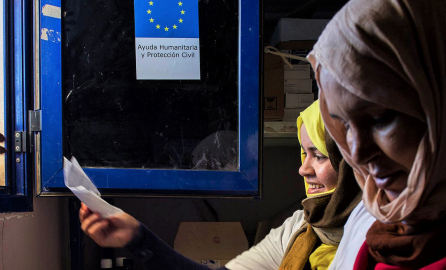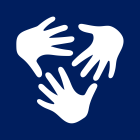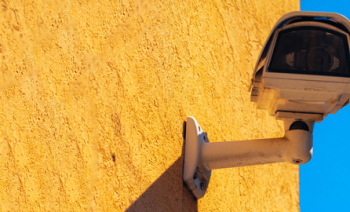Digitalisation in humanitarian assistance presents a twofold dilemma. While digital solutions allow humanitarian organisations to better respond to crises, if mismanaged, these same technologies risk exposing intended beneficiaries to violations of their rights.
Earlier this year, we attended the Digitalisation in Humanitarian Aid workshop organised by the European Commission’s Directorate General for Civil Protection and Humanitarian Aid Operations (DG ECHO), which brought together experts from the humanitarian world, the private and public sector, and the IT field. We sat down with a few panellists to discuss how the digital transformation will impact humanitarian aid, as well as some of the challenges presented by digital technologies.
“Digitalisation is important for everything we do,” said Androulla Kaminara, Director for Africa, Asia, Latin America, Caribbean and Pacific at DG ECHO.
From moves towards more protection of personal data in Europe (GDPR) to growing volumes of response and beneficiary data collected digitally, an understanding of new technologies – both regarding the possibilities and ethics of their use – must keep pace with their proliferation.
“With respect to humanitarian aid, there is potential for delivering assistance much better and faster to people in need,” Kaminara said. “But we must also ensure that we adhere to humanitarian principles. We have to be impartial, independent, and we have to make sure that digital technologies are used in a humane manner.”
A need for dialogue
In the absence of an inter-organisational set of guidelines on the use of digital technologies, consensus-building is an important first step.
“The humanitarian world is not the most tech-savvy,” Kaminara said. “There is a need for more training and identifying the areas where the technically knowledgeable can work together more closely with humanitarian workers.” This need has fuelled dialogue between DG ECHO and partner organisations to understand where digitalisation is already being used effectively, but also the ways in which technologies could be better managed.
Watch Androulla Kaminara discuss how digital technologies are
changing the humanitarian landscape here:
“The field is huge – it covers everything from drones to big data,” Kaminara said. Digital solutions must be paired with ensuring that humanitarian workers understand and are able to use digital technologies effectively and responsibly, she explained.
In particular, the potential for big data is vast. That data should be used in the best interest of the affected populations is a given; it’s the “how” that is still being worked out.
“Having reliable data can save lives – for example in situations where you have people moving out of areas affected by an earthquake,” Kaminara said. “If you have good data, you can target your response to them.” Other benefits of the use of data, she added, include increased accountability to both affected populations and donors, and the ability to better assess the outcomes of a given response.
However, the absence of a digital infrastructure across certain territories, together with the risk of overlooking the ‘digitally invisible’ pose important challenges. Ensuring that digital information is properly protected is a central concern for all parties involved.
“There’s a number of ethical questions that have to be addressed, and this cannot be done by one organisation alone,” Kaminara said. “The structures to answer these questions are not in place, so there’s a vacuum. What will be important is using the knowledge of those concerned to bring forward a collective agenda. This is where we, as DG ECHO, set our priorities - the risks can only be mitigated if we all work together.”
Implementing data in response programmes
Among the organisations thinking through the implications of digital technologies in humanitarian work is the International Committee of the Red Cross (ICRC).
“...we need to embrace technology, understand how it works and ensure it’s used in a responsible manner.”
“Digital technology is important to improve both internal processes and the way people interact with the organisations,” said Romain Bircher, ICRC's Deputy Director of Communication and Information Management. “At the ICRC, we need to embrace technology, understand how it works and ensure it’s used in a responsible manner,” he said. Asking “who is empowered by technology?” is key in this process. For Bircher, the answer needs to point squarely to the most vulnerable.
The impact of digitalisation on the daily work of the ICRC has ranged from the development of protection databases to assist ICRC Delegates in decision making, to creating more secure repositories for sensitive information.
“But digitalisation also helps people work together in a more collaborative manner,” Bircher said. Big data, for example, is being used by the ICRC to identify influencers in resolving crisis situations. “A network of people is quite important; to approach the right person on the ground makes a difference,” he added.
Changing expectations
Digitalisation has also altered the expectations that affected populations have of the organisation. “People often turn to information and communication technology (ICT) for aid. They need to be provided with connectivity – a mobile phone may be as important as shelter and food,” Bircher said.
Digitalisation can also improve communication between affected populations and the ICRC, providing an important means of feedback and a tool for shared decision-making.
|
Watch Romain Bircher discuss the role of digital technologies
|
For Bircher, information is assistance in itself, with people needing access to trusted and accurate information, especially in situations of conflict. Giving the example of the ICRC’s work in Mexico, Bircher explained that delivering information to migrants on access to health care, protection and empowerment forms an often vital service.
Another use of digital technologies is the ICRC’s Family Links website, where people can self-register and see if relatives have shared their own whereabouts and status. The site includes facial recognition software, which can help in identifying and tracing family members.
“It’s not only having a positive match and automating information, it’s also going back to the person and asking whether he wants his whereabouts to be communicated to the enquirer,” Bircher said. “Digital footprints can be used to track and target individuals just as they can be used to find a lead on a missing person, so technology needs to be privacy by design.”
Giving people a voice
“Digitalisation is important because we want to give people a voice – to make sure we understand the challenges they face and the needs they have in order to shape a stronger protective response,” said Christian Friis Bach, Secretary General of the Danish Refugee Council (DRC).
The Mixed Migration Monitoring Mechanism Initiative (4Mi), a data platform on mixed migration flows, is a prime example of what this can look like in practice. Created and managed by the DRC and other partners, the initiative holds a threefold purpose: informing policy, debate and programmatic responses to migration; identifying protection gaps; and establishing a deeper knowledge of migration trends. The initiative has collected over 4,000 interviews with migrants, smugglers, and observers, with information being used by the DRC and partners to better assess where, when, and how they can engage.
“Digitalisation is important because we want to give people a voice – to make sure we understand the challenges they face and the needs they have in order to shape a stronger protective response.”
“We moved to the border between Afghanistan and Iran because we can see from the interviews that that’s where violations are happening,” Bach said. “We can see that many women were left behind and captured inside of Libya, so we need to strengthen our protection of women and girls in the country.”
Of course, data protection is an important part of this process, Bach added. Interviews are aggregated before they are analysed, thus preserving the anonymity of interviewees to avoid persecution or further violations of their rights.
But while the data provides grounds for a stronger protection response, Bach said, the politicisation of such information could also serve to restrain or block people’s movement – making control over the data all the more important.
Collaboration and transparency
Outside of 4Mi, digital technologies have played a strongly positive role in the DRC’s activities. Examples of digitalisation in the organisation’s work range from the use of data collection with UNICEF in Southern Africa to strengthen child protection, to the use of digital solutions in cash transfer programmes, and ensuring access to water for migrants.
“Once you have data protection in place, you can also shape a transparency revolution,” Bach said. “We have a new opportunity here to share data and information on our financial flows, to give people a voice so they can influence our operations and ensure accountability. This can be especially important on issues like corruption and sexual exploitation.”
Fully harnessing the power of digital technologies in addressing the problems faced by migrants will also take collaboration, Bach explained – and not just with other humanitarian actors. The DRC has partnered with Microsoft to create interactive tools that can be used with people on the move to obtain feedback on needs and the quality of interventions. Another example is the DRC’s work with IBM on predictive modelling of migration flows.
“The risks must constantly be dealt with and discussed,” Bach said, but he is optimistic about the potential presented by digital technologies. “There are new opportunities that I think can really help us shape a stronger humanitarian response and increase efficiency and equality in our programmes.”
Watch Christian Friis Bach discuss the Mixed Migration Monitoring Mechanism Initiative here:
Image credit: European Union 2018, Louiza Ammi/Flickr via Creative Commons license 2.0.
This article was written by Craig Hill, Journalist and Content Editor at Capacity4dev.




Log in with your EU Login account to post or comment on the platform.